September 27 - October 3, 2015: Issue 233
Te Arawa and Quickstep: Designed by Two Generations of Crowthers and Sailed by Three Generations of Geddes
Three generations of Crowther boats. Lock's 'Deguello', 'Te Arawa' and 'Gipsy Rover' - picture courtesy Jim Geddes
Te Arawa and Quickstep: Sailed by Three Generations of Geddes: RMYC Multihull Division's Lock Crowther Regatta 2015
The RMYC Multihull Division Lock Crowther Regatta 2015 will be held over the October long weekend, starting with an optional Blue Water Classic ocean race on Friday 2 October 2015 for Safety Category 4 equipped boats with 4 inshore races to be sailed over Saturday and Sunday 3-4 October 2015.
This annual regatta, named to honour one of Australia's premier pioneer multihull yacht designers, Lachlan (Lock) Crowther, attracts those who like to race, those who like to cruise, and those who like to see these yachts fly for three days of glorious sailing and fun.
As far as we can count there are five Crowthers among this year's LCR2015 fleet so far: Jim Geddes’ “Te Arawa”, a Crowther Spindrift 45, Darren Drew's "Top Gun", a Crowther 50 Catamaran that's been swapping first place back and forth with Jason Geddes "Quickstep" during RMYC Offshore races in recent months, Greg Bridges' "Windspeed 31", and Don Macintosh's "Windswept 2".
To inspire those who may like to have a great lunch at the Royal Motor Yacht Club next weekend and take in some of the festivities, or as a timely reminder to those who haven't sent their entry form in yet that they better get busy, we'd like to share an insight into two Crowther yachts that will be part of this year's Lock Crowther Regatta which in many ways illustrate the range and depth of what this very special annual regatta is all about.
RMYC member Jim Geddes’ “Te Arawa”, a Crowther Spindrift 45, is perhaps the oldest Lock Crowther boat still on Pittwater, while his youngest son Jason's "Quickstep", designed and built by Lock's son Brett Crowther and Stuart Bloomfield, may also be the youngest in the Crowther legacy of fine racing vessels.
Jim Geddes on the Te Arawa
PON: The Te Arawa Jim – how did this all begin Jim?
JG: I went with the first Australian Surfing Team to Hawaii when I was 17 with Bob Evans. While I was there in Honolulu one of the beach boys, Nappi was short of crew, being in fact down to one, himself, in taking one of the tourist catamarans out – there were four of these. He asked us all if we knew how to sail and like an idiot I put my hand up. He asked me what I had sailed; ‘A VJ’. He thought this was a J Boat, which is a hundred and ten feet long.
He asked can I work a mainsheet, to which I replied, ‘yes, I can.’, so he said ‘come and help me’.
I followed him down the beach and we spent the day taking tourists out through the surf and back. The boat was designed by a fellow by the name of Rudy Choy, it had no engine, a beautiful boat to sail.
While Nappi ran the boat and I would steer when he went for’ard to do something and when not doing that my job was to supply the tourists with Mai Tais.
To cut a long story short, I was that impressed I worked the rest of the week with him and he gave me a roll of notes. I asked; ‘what’s this for?’ – he said ‘that’s your share of the tips, which went up because you went around three times with the Mai Tai’s’.
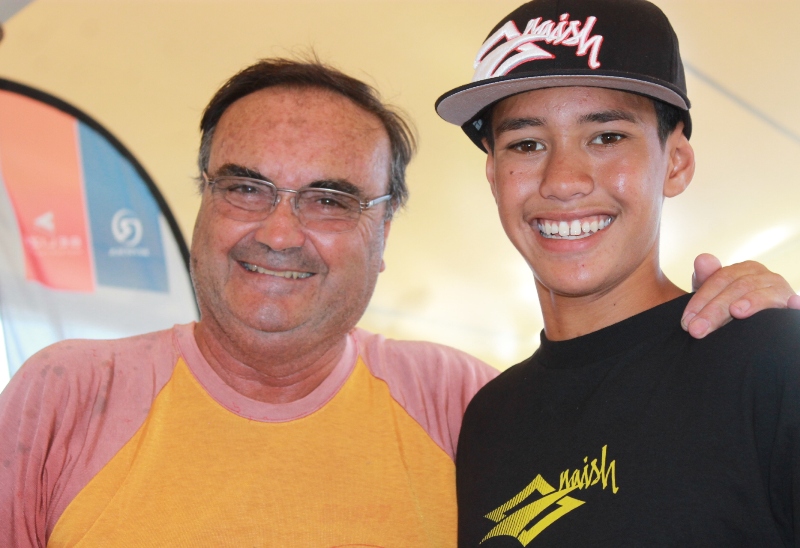
Jim and Riggs - grandson of Nappy Napoleon, whom Jim met at the RMYC's Inaugural Scotland Island Paddle Race in 2014
PON: Everyone was pretty happy then?
JG: Yes, or drunk. On the way back to Australia I thought ‘I’ve got to get a boat like that’. We lived at the beach at Narrabeen and I wanted to sail out through the surf.
When I came home I found a designer, Rod McAlpine Downie and we built a Yachting World Catamaran at my brother-in-laws – it was only 15 feet, and we could sail this out through the surf. These are all gone now, none left.
I was still aiming to build a bigger one though. When Lock Crowther designed something that was very similar to what Rudy Choy had designed I bought the plans off Lock and my brother-in-law and myself built it in my mum’s backyard at Narrabeen.
We had worked out how we could get it out when we began building, but in the meantime, while we were building it, a house was built where the crane was gong to go.
On a Saturday in October in 1975 she was ready to launch. Fortunately Lilley Brothers came along with a bulldozer, towed her down the sandhill at low tide. There was a bit of a surf running but it wasn’t too bad.
A mate of mine attached a safety line to her, and he had his powerful power boat offshore, and we made it out through the surf.
He didn’t have her mast on yet, just an outboard motor, and so she was fairly light. We towed her around to Pittwater to fit her out.
She’s a fantastic boat and we’ve done a lot of miles in her, and a lot of races too.
Owner 'Slim Jim' with superb boat builder Steve Leys - off to Pittwater!
PON: What does the name ‘Te Arawa’ mean?
JG: It’s a bit ambiguous – it’s describing the way a shark swims through the water with little wake. The meaning is far deeper than that though. I had met an old guy here who was a New Zealand Maori Chief, we stayed with him for a while. He found out from my mother that I was building a catamaran;
‘You’re building a boat?’
‘Yes Bill.’
‘Have you got a name for it yet?’
‘No I haven’t.’
‘Well, you may use, you may use mind, Te Arawa.’
‘That’s interesting – thanks very much Bill – why this name?’
‘Well, ‘ he said ‘the original Te Arawa brought the original people who settled in Rotorua many hundreds of years ago and it made many voyages backwards and forwards to Rarotonga and is considered a lucky boat and therefore is a lucky name. And I give you that because a mug like you is going to need all the luck he can get’
And you know what, he was right!
PON: Wouldn’t the Te Arawa be one of the oldest Lock Crowther’s on Pittwater?
JG: I think she probably is. There’s not too many left – a mate of mine has one down in Hastings, in Victoria.
PON: She’s a beautiful boat. You also make her available for others to experience sailing and are among those who volunteer to take children out when RMYC BB has visitors from the Royal Far West at Manly. Has she done longer voyages than those you do on Pittwater?
JG: Yes, she’s been to the Whitsundays three times and I don’t know how many times to Brisbane, to Lake Macquarie ten or more times – she won’t go south, I’ve tried to sail south but she just gives out ‘nope, not going’.
PON: She must be a warm water creature then?
JG: Yes, I think she may be.
PON: Have there been any challenging spots she’s been in during these longer trips?
JG: Oh yes, a few. One of the worst ones we were in was when we’d sailed past Coffs Harbour and the weather forecast changed to a gale warning instead of just a strong wind warning. Although this was coming from the south it turned pretty nasty quite quickly and all the bar ports, including Southport, got closed.
There was no good in staying near the coast, it was too dangerous, so we headed offshore and went about 25 miles out. It was a lot calmer out there, there was still a big swell, but it wasn’t as bad wind wise. We just rolled up all sails and went with it, she’s a great boat for doing that. When all else fails in a boat, if you can’t run safely with the sea and the wind, you’re in real trouble because you can’t turn around and go into it. Well you can, but you’re going to wreck the boat and tire your crew out in no time.
With no sail at all she was doing 5-7 knots – we still had steerage and could go further to sea or closer to the land if we wanted to. So she has great safety attributes, we didn’t have to tow any lines, we didn’t take any water on deck and these were big waves too.
PON: Did you know Lock Crowther?
JG: Oh yes, he was a good mate of mine. He was a great bloke and a very good sailor. All the time he was sailing he was thinking of new designs. One of the great things he discovered was the hulls cantered out. A lot of people don’t understand that this increases the beam of the vessel right at the waterline, so you have a stiffer vessel to absorb the power of the sail. When the boat heels slightly it’s straight up and down. There are a lot of things he did – rotating masts – so many contributions you could do an article just on those.
His contribution to sailing was enormous.
I was on the Lock Crowther we built, Te Arawa, in the Whitsundays when we got the news that he had passed away. It was really upsetting. He was gone far too soon and to young.
I had a lot of time for Lock and he was always available to help out if we had a problem with the building of Te Arawa. If I wanted to alter something I always ran it past him first particularly with Multihulls as you can’t interfere with the structure. They’re built more like aircraft than boats and each detail is finessed.
Multihulls are the oldest vessel in the world that we know of to sail into the wind.
PON: What’s the best thing about sailing for you Jim?
JG: The people and the feeling. I’ve sailed in boats so long now, that it owns us, it’s a second nature. I have learnt a lot of things at sea, mostly about myself and some of these things may be what I wouldn’t want to know, but I think it helps you grow as a person.
Our eldest son was 12 and the one younger was around 8, and they were on the boat (Te Arawa)when she went out through the surf, they got billeted at that age, so they’ve had it for a long time too.
They were on her when we did our first sail and have sailed quite a lot of ocean races and now I’ve lost them to Jason’s boat Quickstep.
PON: Quickstep’s a fantastic boat – she’s beautiful.
JG: Yeah, sometimes, not when she’s doing close to 30 knots! The best Te Arawa has done is 23. A classic example of Crowther designs is the Quickstep, designed by Lock's son, Brett. That boat, even today, is still so far in advance of anything else.
PON: So you are going in the Lock Crowther Regatta for 2015 – what are you looking forward to?
JG: We go in the Cruising Division now, so we don’t have to set spinnakers or worry ourselves with other stuff. We cruise and try and fire the barbecue up as we go around.
You will see us out in the Twilight Races too this year, which I think makes us the oldest boat in the fleet with the oldest crew. Bob Basham is a crew member, and he’s in his 80’s, and Tony Marletta who used to be the Commodore of the club, and Gavin Williamson – they’re all over 70 – I think it keeps us all young.
Te Arawa - built for comfort
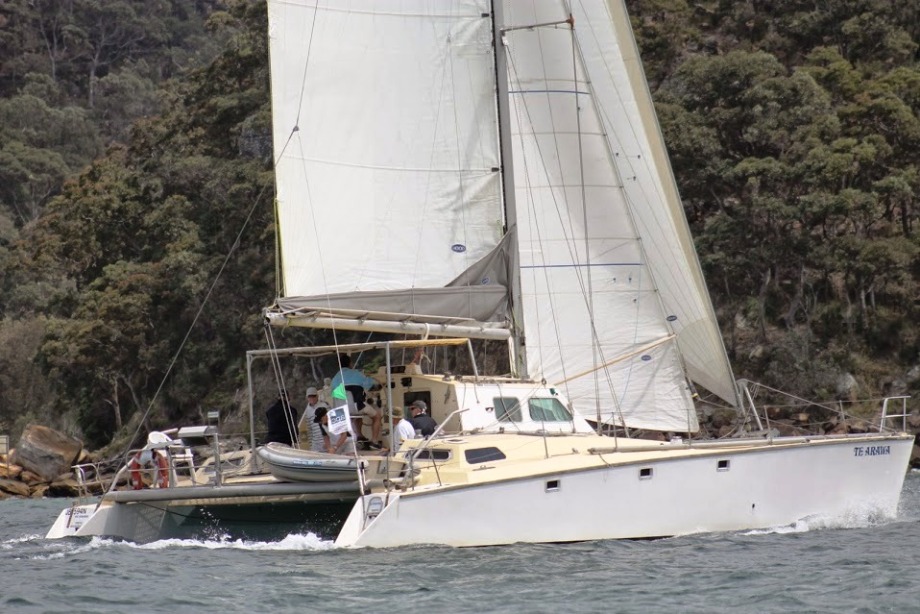
Te Arawa today
Frank and Greg Geddes on the Te Arawa
The Build: It was so long ago but a few memories still stick with me.
I remember seeing Te Arawa’s 45’ hulls being carried around from the end of Albermarle Street along the top of the beach to my Grandmother’s backyard.
About 30 of Dad’s mates were called into action to do the heavy lifting. The hulls had been constructed at a Pennant Hills peach farm and brought to Narrabeen on a massive truck.
The hulls were too big to fit down the side of the house. Dad probably didn’t think that one through but it all worked out in the end.
Greg remembers crawling around inside the boat while it was being finished (it was like a massive cubby house) and being covered in super itchy fibreglass dust. Not even jumping in the surf could get the stuff off.
The launch: We were both in cabin when Te Arawa was dragged into the water and towed out through the surf. Then we hit a wave on the way out and the impact caused the stove to jump off its mounting and crash onto the cabin floor. Dad and his mates were on deck running around shouting. Greg and I learnt a few new swear words that day.
As quick as the chaos started it stopped and we were soon out past the break and on our way to Pittwater, much to Dad’s relief.
Greg and Frank: 'You're not leaving us behind' - picture courtesy Jim Geddes
Best trip: I went as part of the crew on Te Arawa when Dad entered the 1978 Australian Multihull Offshore Championships in Brisbane. I was only 14 with the rest of the crew being Dad’s mates. They soon nicknamed me ‘Jaws’ due to my enormous appetite.
We did 5 races in and around Moreton Bay culminating in the Brisbane to Gladstone Yacht Race. This race is usually a downwind affair with South Easterly winds dominating. Boats can fly spinnakers for most of the way and we were looking forward to a comfortable fast sail. This did not happen in 1978.
The wind came out of the North and blew for 3 days. We had to do ‘a million’ tacks to get past Fraser Island and the sea was pretty rough. I remember being so seasick I could only eat a boiled egg on the roughest day. I didn’t get my appetite back until we reached the calm harbour of Gladstone. I left Dad in Gladstone and flew back to Sydney and then went back to school.
It was quite a surreal feeling seeing my classmates after being away with a bunch of Dad’s wild mates.
Much later we cruised to Port Stephens in Te Arawa. Our crew was my wife Kylie, Jason (my younger brother), Fletcher (Kylie’s brother) and me.
Our first day started with us motoring out of Pittwater in no wind and ended with us sheltering in Newcastle harbour while a North Easterly gale raged in Stockton Bight.
The next day with a nice Southerly blowing we had a glorious sail to Port Stephens. We spent a magical few days exploring the bays and beaches with plenty of good food and drink.
We then waited for a favourable North Easter to blow us back to Pittwater. A great time was had by all.
Party boat Vs. Race Boat
Te Arawa is a great platform built for comfort. It has 4 double berths, full kitchen and 2 toilets (very important to have choice). Nothing beats lying in the nets between the bows having a couple of cold ones while the BBQ is cooking. The fact that it is relatively easy to sail also helps.
Quickstep however is another animal not to say it has not seen its share of partying. It is nowhere near as well equipped as Te Arawa but the basics such as a big esky are well and truly covered.
It is also very different to sail and the crew need to be ‘on’ if there is a decent breeze blowing.
Jason Geddes on Quickstep
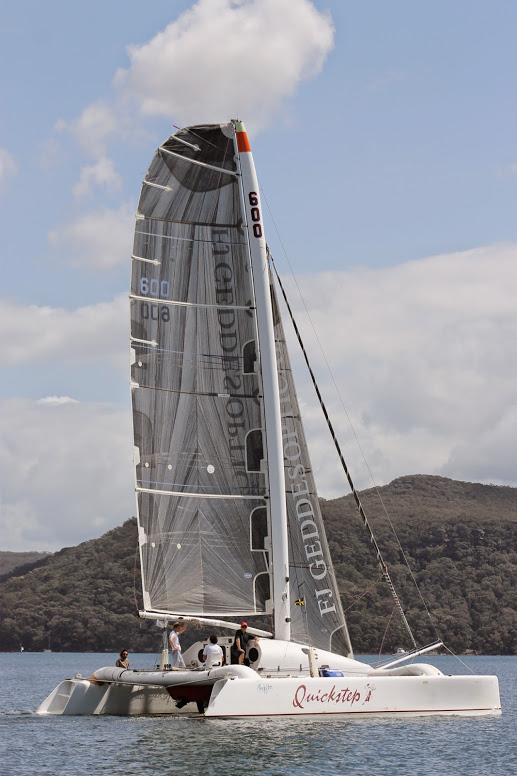 PON: Who designed the Quickstep Jason?
PON: Who designed the Quickstep Jason?
JaG: The Quickstep was designed by Lock’s son, Brett Crowther, and Stuart Bloomfield. It was built and launched in 1999 in Port Douglas. She’s 12.6metres by 7 metres wide, her mast height is 15 metres and it’s a rotating wing mast.
I bought it in 2003 when the boat was already down here off Bill Salisbury. She was originally named Warrior Princess and Bill renamed her ‘Quickstep’.
PON: Why did he rename her ‘Quickstep’?
JaG: The gentleman I bought her off, Bill, is an avid dancer. He can do everything, rock and roll dancing, quicksteps, you name it, he can do it. He’s been in his 80’s for as long as I can remember, for decades – I’ve known him for 35 years now and he’s still in his 80’s.
PON: Do you think it’s an appropriate name for her – is she quick?
JaG: Oh yes, it’s a good name for her. When we bought it some people said we’d have trouble with it stalling all the time, and these renamed it ‘Quickstop’…That’s alright, I make up other names for other people’s boats too – so I got them back.
PON: And inaccurate too, she flies. I remember going over Newport hill at last year’s Lock Crowther Regatta to check on the Friday Ocean Race soon after that started and you were already heading back past Bilgola to go back into Pittwater!
Why did you buy her?
JaG: It was too good an opportunity to pass up. I saw the potential in the boat and thought we would be able to get the best out of it. Through trial and error and learning how to use the boat the way it was meant to be used, what she was designed for, we’ve been able to do just that.
We haven’t changed it much at all and she’s quite a unique design in a lot of aspects, apart from the rotating wing mast, the steering system is quite different from a lot of boats as the rudders are in drums. These go up and down within the drum and the whole drum turns. This is a high speed craft, she sails better when at a high speed, and is not so manoeuvrable at a low speed.
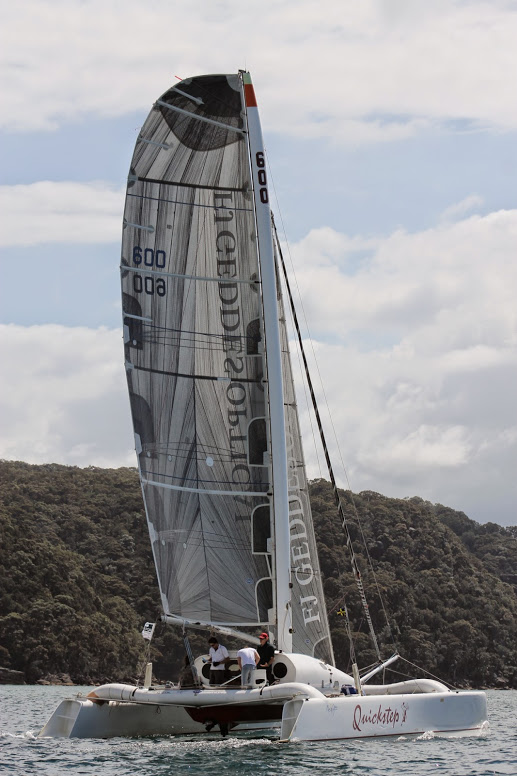 PON: Frank says she’s the race boat for the family, whereas Te Arawa is the party boat – what races has she been in?
PON: Frank says she’s the race boat for the family, whereas Te Arawa is the party boat – what races has she been in?
JaG: We do all of the races at The Royal Motor Yacht Club; the Saturday Multihull race and we’re in the Offshore Division of The Royal Motor Yacht Club. We were invited into this in 2004 and I think we may have been the only multihull in this Division at that time. We had something akin to a gentleman’s agreement where we would start just behind them and keep out of the way…
PON: And then overtake the fleet?
JaG: Well, we generally do, we do what’s known as an ‘horizon job’ on them pretty much every time. It was nice of them to invite us into the Offshore Series so I said to not put us into the handicap system as there’s too much difference between the Quickstep and the yachts, and we agreed to just stay out of the way as we love being out there with the other boats and having a sail around together, it’s great being involved in these short coastal races.
PON: What’s the longest race she’s been in?
JaG: The Port Stephens race – this was an overnight race. We started a 9 o’clock at night and got there at 8 o’clock the next morning. It rained all night and Frank and I sailed the boat while Greg and our brother-in-law Fletcher slept all night. They did get up at 5 the next morning and took over then and we had a bit of a rest, so it was alright.
PON: What’s the best thing about sailing for you?
JaG: Well, I was born into it really. When dad launched Te Arawa off the beach I was about 1 year old. I don’t have many memories of the launching but I’ve been sailing on that boat since I was around 12 months old, so it’s in me I guess, part of what is me.
I was lucky as I also fell into a job at Brookvale around 21 years ago at a sail-making company called Hood Sailmakers, so that too has progressed me further in the sailing.
The best thing about it for me is just to be sailing with my brothers, it’s a good outing, there’s plenty of sledging going on – if you can imagine three brothers sailing together, there’s plenty of banter on board (laughs).
PON: Will all three of you be in the Lock Crowther Regatta this year?
JaG: Yes, we’ll be there alright. We’re doing the Friday race and then the Saturday and Sunday as well. We’re looking forward to it, just having the three Geddes boys together plus Fletcher, who is a keen exponent of sledging while on the boat, wherever we are on the race course. I’d like to think we’ll be at the pointy end of the races this year but as we’re always out to have fun, we’ve won anyway.
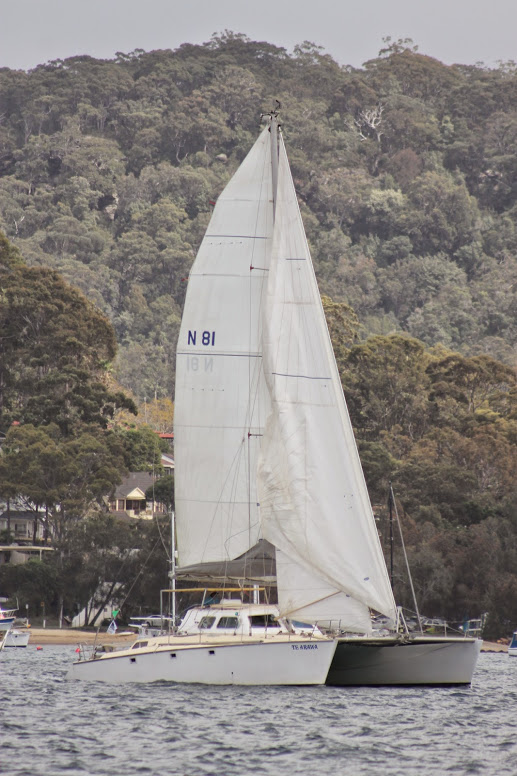 PON: The Te Arawa – what’s your fondest memory of her?
PON: The Te Arawa – what’s your fondest memory of her?
JaG: All of it, the whole lot. We’ve done a lot of coastal cruising, we’ve been to the Whitsundays three times. We’ve lived on board for three months at a time and last time we took the dog with us, our border collie, the dog liked it too.
One memory that does stick in my mind is we always used to go out in the boat over Easter and what I remember about that is it always rained – we never had an Easter when it didn’t rain when we stayed on the boat. We’d be inside playing Monopoly or something like that and the old man would be cooking scones, ‘Righto,’ he’d say, ‘I’m going to cook some scones.’ Or bread, he’d always cook some kind of bread on the boat.
PON: He’s a bit of a super-dad your dad.
JaG: (laughs) He does alright. He’ll do.
PON: Where did you go on these Easter trips?
JaG: We’d stay at Towlers Bay for a night and then go around to Refuge Bay, where the waterfall is. That was always a good spot as when it rained the waterfall was always working. We’d do the usual silly thing and swim ashore and have a shower under the fresh water waterfall and then swim back out to the boat…
PON: Through the saltwater?
JaG: Yeah (laughs). But it’s things like that you remember about growing up on that boat.
PON: Did you meet Lock Crowther?
JaG: I did. I grew up with him around as dad knew him quite well but I was more at his and dad’s elbows. I was still a teenager when he passed away. I met his kids a bit, they used to sail down on Pittwater too. They’ve all gone off and done other things – Brett’s not designing sail boats anymore, he’s into the big ferry market now, and doing well there.
PON: So it’s clearly something that’s going on into the next generation – boat designing and boat building, and similarly it’s sailing in the Geddes family?
JaG: That’s right. What’s happened for us is that Greg’s daughter Rachel, my niece, comes out and does the Saturday races with us every time. Rachel is 14 now and she’s good on the boat, knows how to do everything.
PON: So is that three generations of your family on the Pittwater – what about your grandparents?
JaG: Mum’s dad was a fisherman, and a shipwright, on Pittwater, so that’s another generation. On Dad’s side there were people involved in the steamships going up and down the coast too.
PON: It’s in your blood then, a family of saltwater people...
JaG: I think we just never leave the ocean.
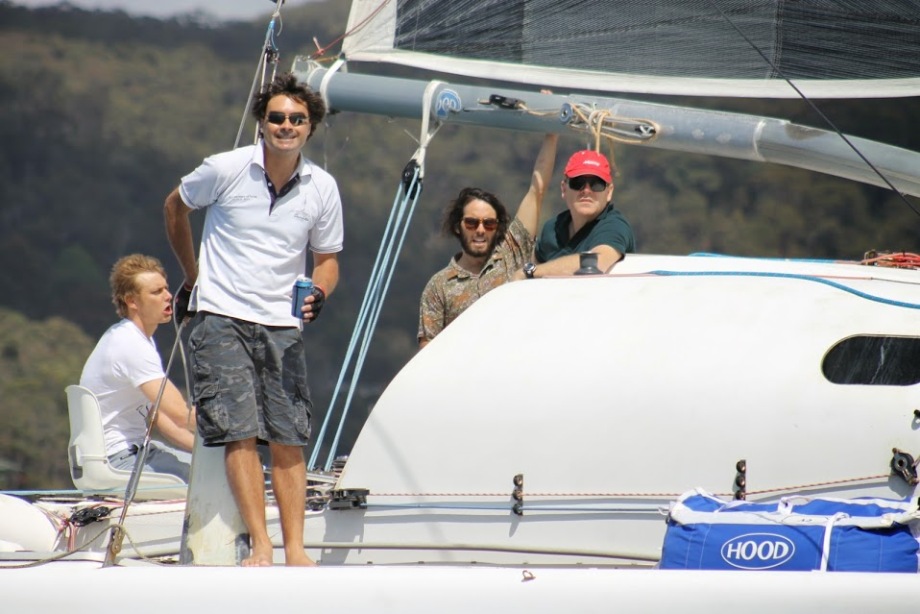
Jason on Quickstep - 2014
__________________________________________________________
RMYC Multihull Division Lock Crowther Regatta 2015
Lock Crowther was regarded as a world class Australian pioneer of multihull yacht design.
We recognise his dedication to the development of the modern multihull and name a Regatta in his honour.
The Lock Crowther Regatta has been hosted by the RMYC since 1996 and offers multihull owners both exciting racing and cruising programs.
Once again the regatta will be held over the October long weekend on the beautiful waters of Pittwater and Broken Bay, NSW - starting with an optional Blue Water Classic ocean race on Friday 2 October 2015 for Safety Category 4 equipped boats with 4 inshore races to be sailed over Saturday and Sunday 3-4 October 2015.
And for the second year running, "off the beach" multihulls are invited to attend!
For the tenth year running APC Logistics, a major Australian-based international freight forwarding company, has signed on as principal and title sponsor of the 2015 event. We acknowledge and thank them warmly for their ongoing, generous support.
Here's an outline of what we have arranged for the weekend:
• Five races over three days • Exciting prize pool on offer
• First class marina facilities • PHS, OMR & VYC handicap formats
• Launching area for trailable boats • Family entertainment facilities including swimming pool
• Trailer storage area • Courtesy bus to shops/chandlery
• Friday evening welcome BBQ • Breakfast and take-away lunch available
• Free skipper's regatta shirt • "off the beach" entries welcome
All this for only $150 entry fee unchanged from last year!
Don't miss it!
Please click HERE for the 2015 Notice of Race, Entry Form and regatta shirt ordering information.
The online Entry Form includes help instructions. And you can pay securely online as well as upload a photo and other details of your boat if you wish!
"Off the Beach" boats, please choose the OTB Regatta Entry Form.
Sailing Instructions will be available for download towards the end of September 2015. Entry Form now available here: www.royalmotor.com.au/multihulls/Crowther.html
Surfboard team to race in Hawaii: 1961
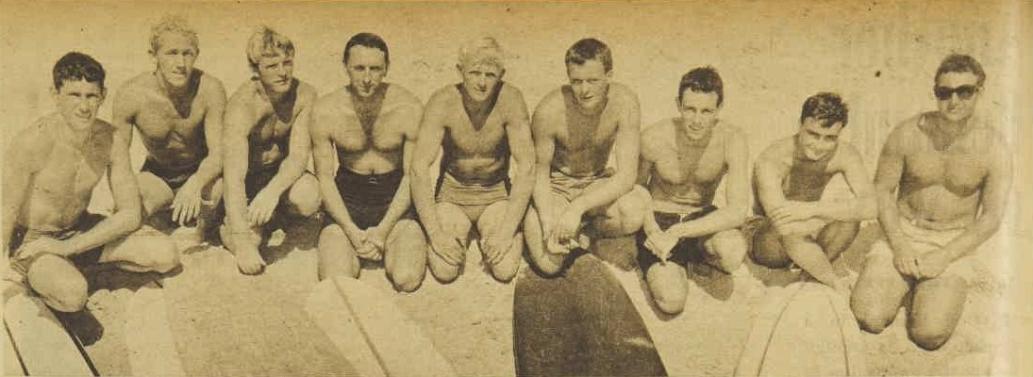
REPRESENTING AUSTRALIA for the first time at the International Surfing Championships in Hawaii, these boys are members of the 20-strong team. From left: Owen Pilon, David Jackman, Mick McMahon, Bob Evans, Ian Wallis, Ken Bate, Graeme Treloar, Jim Geddes, and Graham Henry.
Surfboard team to race in Hawaii
By Kerry Yates
This week 20 Australian surfboard riders, eight of them teenagers, will meet in Hawaii to form a team to compete in the International Surfing Championships at Makaha Beach in December and January.
IT will be the first time Australia has been represented by an organised team at the championships, which bring competitors and spectators from all over the world every year.
All members of the team paid their own fares to realise this dream of most surfboard experts. Some used the savings of two or three years to travel by ship. Others took advantage of an air-line company's "fly now, pay later" plan.
Unlike most overseas travellers, the boys didn't take much luggage. Swimsuits, "ziptweeds" (long pants worn on surfboards), and a few casual clothes were all they thought they'd need - so that's all they took.
And, of course, their boards! Each of them took two boards-a special malibu-type, the light and easy-to-handle board used on most Australian beaches, and a big, solid "elephant-gun" board, used in heavy surf.
Bob Evans, of Narrabeen(one of Sydney's northern beaches), organised the team and arranged for it to compete in the championships.
The boys will contest junior and senior surfboard champion-ships and body-surfing events.
The South Pacific Surf Riders' Club supplied the team with T-shirts in the Australian national colors-gold and green.
This newly formed club, which has a modern clubhouse at Narrabeen, hopes to sponsor an Australian team to Hawaii for the surfing titles each year.
The members of the Australian team are:
Bob Evans, at 32, is the oldest member of the team. He believes that some of the Sydney surf-riders will be a real challenge to the established champions from California.
David Jackman, 21, of Harbord, is a surfboard builder by trade and well known to Sydney board-riders as "Jacko," the boy who rode four big waves over the Queenscliff bombora earlier this year.
John Williams, 21, of Queenscliff, is another surfboard builder.
Owen Pilon, 18, of North Narrabeen, is a process worker in a city electrical firm and has saved for this trip since he started work several years ago.
Graham Henry, 20, of Harbord, is known as "Buz." He works hard at various jobs during the winter so that he can spend the whole of summer riding the waves.
Mike Hickey, 24, of Bilgola, gave up his job as an insurance clerk to become a member of the Australian team.
Jim Geddes, 17, of Narrabeen, sat for the last exam for his Leaving Certificate at his school, Waverley College, a few days before leaving Sydney for Hawaii.
Ian Wallis, 21, of Collaroy, is a city storeman and describes Hawaii as "the surfboard rider paradise."
Bernard Farrelly, 16 of Narrabeen, is known as “The Midget." A surfboard builder by trade, Bernard was the junior champion of Sydney's surfboard riders this year.
Bob Pike, 21, of Manly is a wool classer and says his main interest in going to Hawaii is to see if the waves are really as big as everyone says.
Mick McMahon, 25, of Harbord, is a butcher. Before leaving he said, "I’m keen to have ago at the big waves and look at the Hawaiian girls."
Graeme Treloar, of Manly, is a commercial traveller and Sydney's senior surf-board champion.
Gordon Simpson, 21, Harbord, is a former State surf champion.
Ron Grant, 22, of Wollongong, is the only non-Sydney member of the team and the only one who has previously competed in surf races overseas - in California.
Ken Bate, 18, of Manly, works in a city stockbrokers and has been saving for this trip since he started work three years ago.
John Bill, 20, of Manly, gave up his job as an accountant to join the team.
Ben Acton, 25, of Harbord, a member of the Police Force, got leave of absence to make the trip.
The other three members of the team are Reg Shortland,19, Laurie Short, 18, and Roy Sloan, 18, all of Maroubra.
Surfboard team to race in Hawaii. (1961, December 6). The Australian Women's Weekly (1933 - 1982), p. 46 Supplement: Teenagers' Weekly. Retrieved from http://nla.gov.au/nla.news-article51392771
